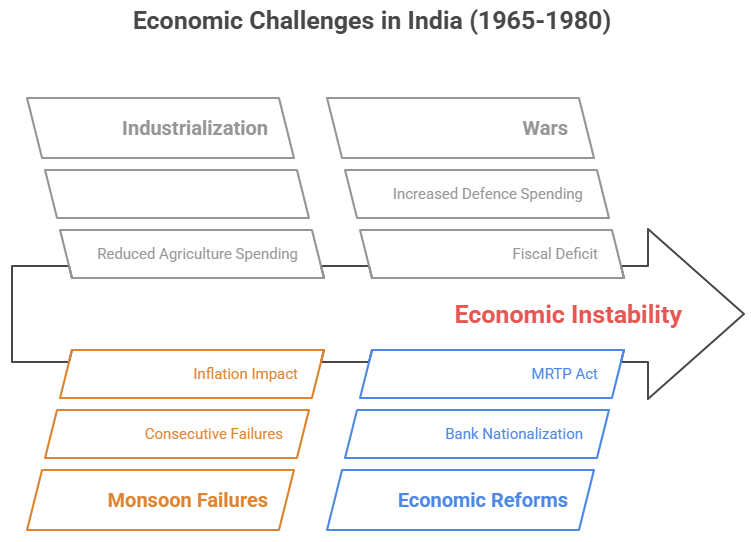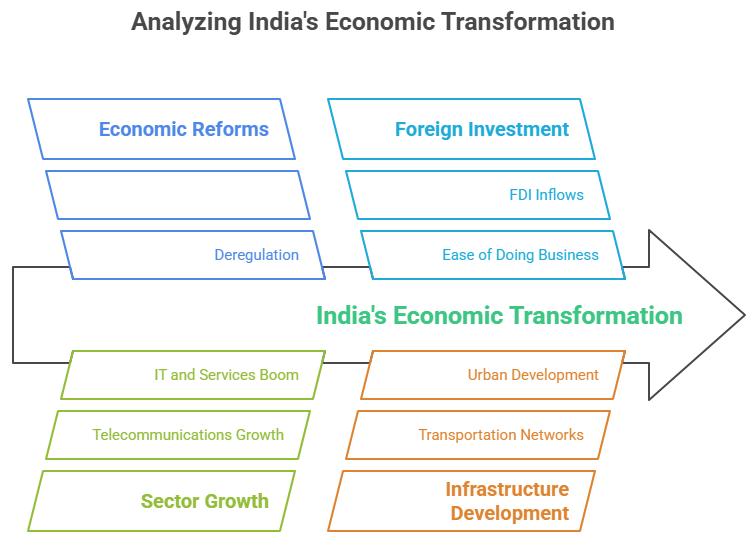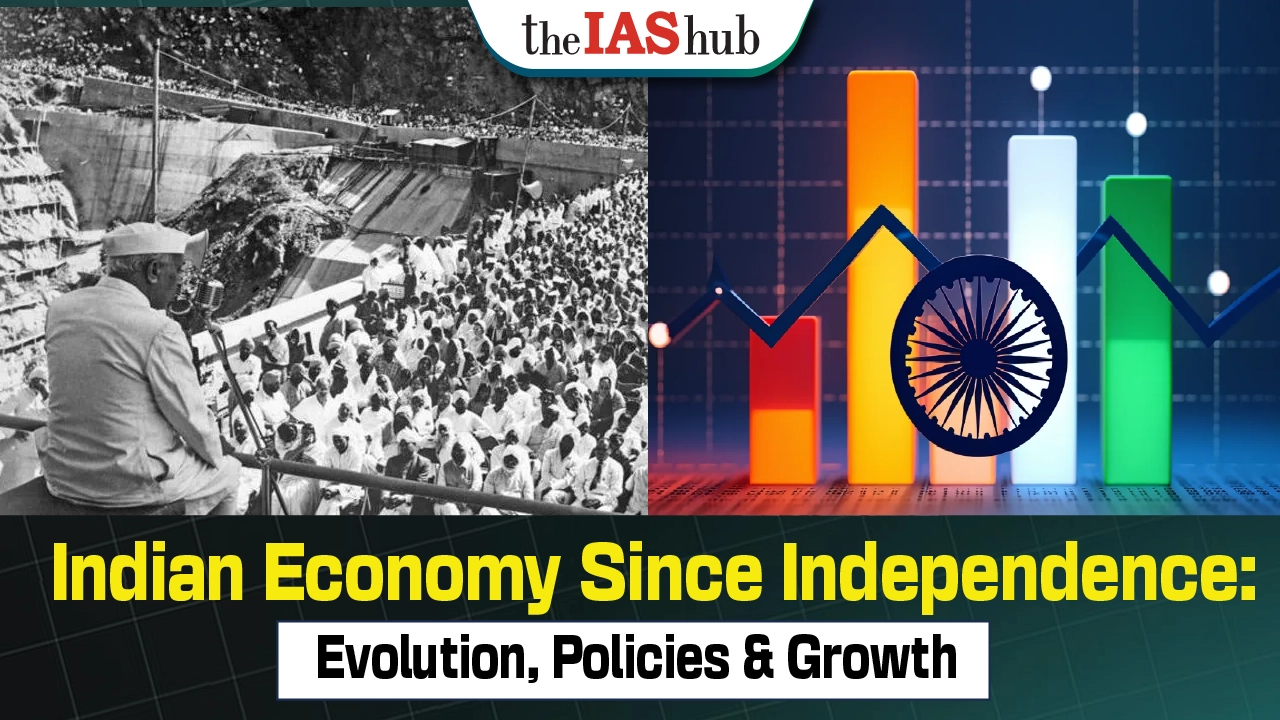Post-independence, India embarked on a journey to develop its economy and uplift its citizens from poverty. Here is an overview of the history of Indian economy development since independence
Indian Economy During Nehruvian Era (1950s–1960s)
- Five-Year Plans: These plans focused on industrialization, agrarian reforms, infrastructure development, and social welfare.
- Mixed Economy model with a combination of public sector enterprises and private sector participation. Nationalization of key industries and dominant role of the government in economic planning and regulation.
- Import Substitution Industrialization (ISI) policy aimed to reduce dependence on imports through protective tariffs and licenses.
- Growth of self-reliant industrial base but faced challenges of inefficiency and quality concerns.
- Economic challenges including low per capita income, widespread poverty, low literacy rates, and inadequate infrastructure.
- Instances of macroeconomic imbalances, such as inflation and balance of payments issues.
Industrialization and Public Sector Development in the Indian Economy
- Emphasis on the development of heavy industries such as steel, power, and machinery. Notable projects like the Bhakra-Nangal Dam and the establishment of the Steel Authority of India (SAIL).
- Establishment of public sector enterprises like Hindustan Aeronautics Limited (HAL), Bharat Heavy Electricals Limited (BHEL), and Indian Oil Corporation (IOC). Public sector enterprises played a crucial role in promoting industrial growth and self-reliance in key sectors of the economy.
Agricultural Reforms and Food Security in Indian Economy
- Agrarian reforms introduced by Nehru to address issues of landlessness, tenancy, and unequal land distribution. Measures such as the abolition of intermediaries and implementation of land ceiling laws aimed at improving agricultural productivity and reducing inequality.
- Community development programs initiated by Nehru focused on rural development, agricultural extension services, and promotion of cooperative societies.
Infrastructure Development
- Construction of dams, irrigation canals, and hydroelectric power projects to enhance agricultural productivity, generate electricity, and provide irrigation facilities.
- Emphasis on the expansion of railways and road networks to improve transportation, trade, and connectivity across the country
Issues with Indian Economy during Nehruvian Phase
- Slumped growth of agriculture: From 1951 to 1965, industry grew at 7.1% annually. Agriculture received less attention, spending reduced during second Five Year Plan. Sector developed at over 3% per year, more resources could have accelerated growth.
- Dependence on foreign aid for development projects, creating dependencies and limiting self-reliance.
- Implementation of price controls and subsidies on essential commodities to address social welfare concerns, but resulting in distortions, black markets, and inflationary pressures.
- Limited Industrial Growth: The focus on public sector enterprises and import substitution policies led to inefficiencies and lack of competition, hindering industrial development.
Indian Economy between 1965 to 1980
- Rapid industrialization reduced agriculture spending, second Plan saw 50% cut.
- The failure of the monsoon and its impact on inflation.
- Consecutive monsoon failures in 1965 and 1966 worsened the already stagnant agriculture sector, leading to a decline in agricultural output.
- The USA decided not to renew the long-term PL-480 (wheat loan) agreement with India due to India's stance on Vietnam.
- Impact of Wars: The conflicts in 1962 and 1965 led to increased defence spending, causing a fiscal deficit of 7.3% of GDP for the governments in 1966-67.
- The balance of payments situation worsened due to insufficient reserves. Foreign exchange reserves averaged around $340 million from 1964-65 to 1966-67, which was not enough to cover even two months of imports.
- Foreign aid has become increasingly relied upon during the first three Plans, but now its dependence has significantly grown due to food shortages and a negative balance of payments.
- Reform measures: After 1967, a series of radical economic policies were implemented in India, which had a lasting impact on the country's development efforts. The user mentioned that there are some things that they want to discuss.
- On July 20, 1969, the 14 major private commercial banks underwent nationalisation.
- In 1972, insurance was nationalised.
- In 1973, the coal industry underwent nationalisation in the power sector.
- Aims of reforms: The move aimed to increase bank lending to agriculture, as big businesses were dominating the credit flow.
- In 1969, the Monopoly and Restrictive Trade Practises Act (MRTP) was passed to promote a competitive environment in business by imposing restrictions on the activities of large business houses.
- After 1969, any business group with assets exceeding Rs. 20 crores were deemed a monopoly and prohibited from further business expansion.

Control and Intervention Measures in Indian Economy
- Foreign Exchange and Regulation Act (FERA) enacted in 1973 imposed strict regulations on foreign investment in India.
- Nationalisation: The government has chosen to acquire and manage struggling companies, including textile mills, instead of letting them shut down.
- India briefly suspended its five-year plans and instead implemented annual plans between 1966 and 1969. The country decided not to allocate resources for an extended period.
Industrial Policy of 1977 and Its Impact on Indian Economy
- The policy focused on promoting cottage and small industries in rural areas and small towns.
- The policy classified the small sector into three groups: cottage and household sector, tiny sector, and small-scale industries.
- It aimed to prevent large business houses from gaining a dominant and monopolistic position in the market by limiting their scope.
An analysis of Phase -1
- Bank nationalisation enhanced financial inclusion and increased farm credit.
- Opening of bank branches in rural areas increased financial savings.
- Crony capitalism resulted from lending decisions influenced by politics.
Onset of Balance of Payment Crisis (1980s to 1991) in Indian Economy
- Indira Gandhi devalued the rupee by 57% to address the balance of payments crisis.
- Measures were taken to decrease the fiscal deficit by reducing government spending instead of increasing taxes. The action resulted in increased inflation and faced widespread criticism.
- The sixth five-year plan (1980-85) focused on implementing measures to enhance the economy's competitiveness.
- Delicensing: a series of measures taken to remove price controls, implement fiscal reforms, revamp the public sector, reduce import duties, and end the licencing of the domestic industry. Raj.
- The Industrial Policy of 1980 aimed to boost economic federation, improve the public sector's efficiency, and reverse the decline in industrial production.
- It also expressed support for the Monopolies and Restrictive Trade Practises (MRTP) Act and the Foreign Exchange Regulation Act (FERA).
- During Rajiv Gandhi's tenure as Prime Minister, his government implemented several reforms in the late 1980s.
- These reforms included relaxing the process of granting licences, reducing import restrictions, and introducing export incentives.
- The MRTP asset limit has been increased to Rs. 100 crores, which is five times higher than before.
- The 1985-86 budget reduced direct taxes for companies and increased income tax exemption limits.
- In 1982-83, the government made changes to the capital markets to attract more foreign investments, with a focus on non-resident Indians.
- In the 1980s, India experienced a significant increase in its growth rate, surpassing the previous three-decade record. This growth rate, which was previously referred to as the "Hindu rate of Growth" by Prof. Raj Krishna, reached over 5.5 percent of GDP.
Outcome of efforts of Rajiv Gandhi Government
- The 1980s modifications were a flexible approach within the control regime, but underlying structural weaknesses persisted.
- The issue of a structural bottleneck has not been addressed or resolved. In the 1980s, the Indian economy seemed to be thriving, but underlying structural weaknesses were emerging.
- The user mentions several factors that contributed to the economic situation, including industrial control, the licence raj, the Monopolies and Restrictive Trade Practises Act (MRTP) of 1969, nationalisation of banks and industries, self-sufficiency, and an inward-looking trade policy.
- In the late 1980s, there was a significant trade deficit as imports were almost double the number of exports. This led to export earnings being only 55% of the total imports.
- India began relying heavily on short-term borrowings in the late 1980s.
- India's weak macroeconomic indicators have resulted in negative macroeconomic fundamentals.
- In 1990-91, there were several economic challenges faced by the country including a fiscal deficit of 8.4%, a current account deficit of 3.1%, high inflation of 17%, and a significant foreign debt.
- The Balance of Payments (BoP) is heavily affected by all these factors, causing significant strain.
Liberalization and Globalization (1990s onwards):
- Economic Reforms: Starting in the early 1990s, India initiated economic liberalization and embraced globalization. Reforms included deregulation, liberalization of trade and foreign investment, privatization of state-owned enterprises, and financial sector reforms.
- Liberalization of Key Sectors: Sectors such as telecommunications, information technology, and services experienced significant growth and became key drivers of the Indian economy.
- Foreign Direct Investment (FDI): Policies were implemented to encourage FDI inflows and improve the ease of doing business in India.
- IT and Services Boom: India emerged as a global hub for information technology (IT) services and business process outsourcing (BPO).
- Infrastructure Development: Investments were made in infrastructure, including transportation networks, power generation, and urban development. Initiatives such as the Golden Quadrilateral highway project aimed to enhance connectivity and support economic growth.
- Socioeconomic Progress: There were improvements in areas such as literacy rates, life expectancy, healthcare, and poverty alleviation. Government programs targeted social welfare, rural development, and inclusive growth.

Recent Years
- Emphasis on Ease of Doing Business: India has undertaken reforms to improve the ease of doing business, streamline regulations, and attract investment.
- India jumps 79 positions from 142nd (2014) to 63rd (2019) in 'World Bank's Ease of Doing Business Ranking 2020'.
|
- Digital Transformation: The government has prioritized digitalization and e-governance initiatives, promoting digital payments, expanding internet connectivity, and leveraging technology for service delivery and financial inclusion.
- India with 89.5 million digital transactions in the year 2022 has topped the list of five countries in digital payments, according to data from MyGovIndia.
|
- Start-up Ecosystem: India has witnessed the rise of a vibrant start-up ecosystem, fostering innovation, entrepreneurship, and job creation. Various government initiatives and funding support have boosted the growth of start-ups in sectors like technology, e-commerce, and fintech.
|
The Startup India initiative was launched on 16th January 2016, by the Hon’ble Prime Minister. Since the inception of the initiative:
- There are over 99000+ startups recognized by the government of India as of May 2023
- 49% of them having a base in Tier 2 - Tier 3 cities
- These startups are spread over 669 districts from 36 States and Union Territories of India
- As of 31st March 2023, India is home to 108 unicorns with a total valuation of $ 340.80 Bn.
|
The journey of Indian economic development since independence has seen a transition from a planned economy to economic liberalization, embracing globalization and fostering entrepreneurship. Challenges such as poverty, inequality, and job creation remain, but India has emerged as one of the world's fastest-growing major economies and a key player in the global economy.













